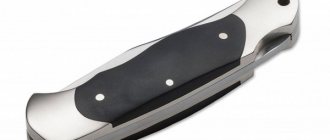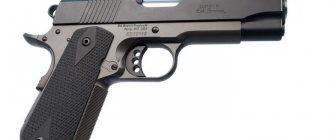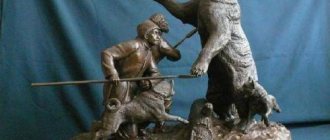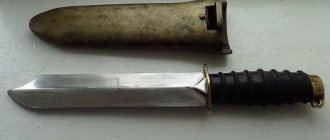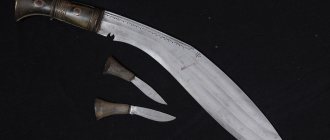The Witcher 3 universe is very cruel. Although it was initially assumed that witchers would be unsurpassed monster killers, it soon became clear that the most terrible monster is sometimes an ordinary person. To fight with people, you need your own weapon, so Geralt carries a steel blade with him, otherwise he can dull the soft silver blade on human flesh.
To make your search easier, we have compiled the top 10 best steel swords in The Witcher 3.
Wolf School Steel Sword
This blade, like the Wolf set as a whole, is very balanced and versatile. This steel sword in The Witcher 3 has a good balance of magical and physical damage. Characteristics::
- sign enhancement bonus +11%,
- acceleration of adrenaline release +11%,
- critical hit +11%;
- chance to cause bleeding +11%.
This set of characteristics makes this blade a good option for a universal build.
Improving the characteristics of the sword
Type of flamberge
The Flamberge has several bends, which gives it strong striking power; due to its waves, it is better than a straight classic sword. The appearance of a blade of this shape is explained by the appearance of knightly armor; great emphasis was placed on piercing blows. In the open air, the flamberge was irresistible, but in cramped conditions and city conditions its effectiveness decreased.
The weapons workshops of that time were busy inventing new weapons. The straight sword, which at that time had lost its popularity. New types of piercing and crushing weapons appeared, such as a panzerbrecher, a knife that had four edges for effectively piercing armor, a klevets hammer, a shestoper (a type of mace) and many other types. But the masters of their craft did not forget about the design of the wavy sword, and therefore, they increasingly remembered the flamberge, and created a wavy sword.
The wave flamberge has become popular in Southern Germany. The damage of the blow became smaller, this improved the cutting qualities of the sword, the defeat did not cover a large area, but the result was successful. The piercing blow became more dangerous and stronger, the flamberge seemed to saw through the bones and entrails of the enemy, without having any obstacles in its path, the wavy sword also dealt with shields with ease, the flamberge created the impression of a saw that sawed everything in its path.
Iris
In order for Relic Swords to compete with standard Witcher gear, they must have some kind of stat bonus or at least some useful feature. Iris is one of these steel swords in The Witcher 3.
Olgierd von Everec will give this blade to Geralt after he completes the main quest of the “Hearts of Stone” add-on. Its performance in itself is quite average, but the blade has the ability to gradually accumulate a special charge, and then discharge it with a strong attack with a shock wave.
This strike deals more damage than Aard, but consumes the Witcher's life force. This is definitely one of the more interesting blades on this list, although not the most destructive.
History of appearance and purpose
The two-handed sword is the last type of this weapon invented by mankind. In the era of Antiquity until the beginning of the Renaissance, they used mainly one-handed swords, although their length and weight gradually increased. If Roman gladiuses did not exceed 60 cm and weighed no more than 1 kg, then Carolingian swords “stretched” up to 1 m.
The appearance of two-handed swords in the 14th century led to the improvement of armor. When their relatively reliable plate models were created, lightweight one-handed swords were no longer effective. Shields were also now unnecessary, so the warrior had a free second hand. They began to use it to hold more formidable weapons, capable, with the necessary physical strength and skills, of cutting through or piercing armor. They were practically unsuitable for cutting blows.
Most often, a knight with a two-handed sword fought on foot . But even against a cavalryman he had good chances. It was quite possible to get the enemy off the ground or cripple his horse, forcing him to throw off the rider. In battles, knights with such weapons, after waiting for the right moment, were placed in the vanguard and used as a “battering ram”, punching holes in the enemy’s ranks. The blows were delivered mainly from above or from the side; they could also stab with them, making long lunges. When approaching the enemy, the knight also inflicted significant damage on him, hitting his face or neck with the crosshair of the hilt.
The specific technique of fighting with such a heavy long blade required long training, so it was necessary to start very early. Weapons were most often made to order, taking into account anthropometric data, and as a result, they varied greatly in size and weight. Having lost his own sword, the knight, in principle, could fight with someone else’s weapon, but at the same time he noticeably lost in skill.
The two-handed sword was popular in the Middle Ages, and its appearance was due to the improvement of armor
In close battles, he was often used in the front ranks to break through the enemy army
Weapons were most often made to order, taking into account the anthropometric data of the warrior
True friend
“True Friend” in The Witcher 3 is a steel sword that you receive as a reward for completing the additional quest of the same name. This blade specializes in attrition and direct damage.
Its characteristics:
- +28% intensity of the Aard sign,
- +95% critical strike damage,
- +12% to critical strike chance,
- +15% chance of poisoning.
This set makes “Faithful Friend” an excellent option for aggressive witchers who rely on continuous damage combined with the Aard sign stun. Plus, the wavy blade design is beautiful and unique, so much so that if you base your choice on looks alone, you'll have a hard time replacing it with anything else.
Flamberge - a Western sword with an Eastern blade
Europeans became familiar with bladed weapons with a curved blade during the first Crusades. However, it did not take root in Europe - the battles took place mainly in cities, where it was problematic to swing a really strong chopping blow with a light saber. And a weak blow was clearly not enough to pierce even relatively thin steel armor. And the curved saber was unusual for the knight’s hand.
But still, the idea received some development. Around the fifteenth century, long weapons with a wavy blade began to be made in Germany. It became especially widespread during the Thirty Years' War - perhaps the most difficult in the history of the German people. Of course, it was a flamberge sword - anyone with even the slightest interest in edged weapons can easily recognize its photo.
The gunsmiths knew that one of the advantages of the Arab saber was its small impact area, which, with sufficient force, could easily cut through the armor.
Therefore, it was decided not to reduce the size and weight of the good old sword, but instead simply reduce the area of contact with the armor. It was for this purpose that instead of a straight blade they began to make a wavy one. Of course, as a result of this, the area was significantly reduced, which led to an increase in the impact force - this was precisely the goal that the gunsmiths pursued.
They were predominantly two-handed in order to provide maximum striking force. The heavy sword flamberge, whose weight reached 4 kilograms or more, in skillful hands could crush almost any armor.
Sword from Viroledo
If you prefer a saber look, the steel sword from Viroledo is a great option. Geralt can get this blade in the “Blood and Wine” add-on by making it from a blacksmith according to the recipe of the same name.
Characteristics:
- +75% critical strike damage,
- +15% crit chance,
- +15% chance to cause bleeding,
- +15% to poison
- +3% instant kill chance.
The blade from Viroledo is suitable for those who like to kill with one hit and crit. If the enemies do not die immediately, they will bleed and get poisoned. It's cruel.
Flaming Sword
Gradually, swords became a thing of the past - when the first muskets and pistols appeared. But they were replaced by swords. Few people know, but for some time flamberge swords were also made.
They retained all the advantages that swords had - they easily pierced light armor, gradually extinguished the blow received by the blade, and did not get stuck in the body of a defeated enemy.
But their advantages did not end there. An experienced warrior, wearing a thick leather glove, could intercept an ordinary sword, immediately after which he could easily pierce the enemy. This technique did not work with a flaming sword - it was enough to pull it towards yourself to simply leave the enemy without fingers.
Vitis
The steel sword Vitis in The Witcher 3 can be obtained in the Land of a Thousand Tales, next to Longilocks' Tower, if you follow the will-o'-the-wisp. This blade is ideal for a mage build and all those witchers who prefer to use magic instead of bluntly punching them in the snout.
Gives +20% to the strength of all witcher signs.
This is a great option for those who use the armor of the Griffin school or love magic. Plus it looks like a gorgeous rapier with an elegant hilt and guard.
Attitude towards owners
Many sources that describe Flamberge swords also mention the people who owned them.
Often these were Landsknechts, or Doppelsoldners. The last term can be literally translated as “double soldiers.” Why? It's simple. Because they always received double salary. True, every coin spent was justified.
To begin with, mercenaries (and soldiers of the regular army almost never used flamberges), armed with these terrible weapons, were always placed in the first line before the battle. That is, the main blow fell on them. They did this not in order to get rid of the mercenaries and not pay them after the battle. Simply working with a long flamberge while in the midst of allies was very problematic and completely unproductive. But chopping long spears and crushing the enemy’s armor and helmets with a good swing is just that. Since the two-handed flamberge sword had a very large weight (for comparison, an ordinary bastard sword rarely weighed more than 2 kilograms), it easily cut through thick shafts. Of course, the mortality rate was simply enormous. Such a risk had to be paid well.
However, the owners of the flamberges were fiercely hated by both enemies and allies. Simply because the swords caused so-called vile wounds - non-healing ones.
Therefore, mostly warriors captured with such weapons were hanged right on the spot. It is not surprising that such people have gained the reputation of daredevils who are not afraid of anything or anyone.
Bluff
The steel sword “Bluff” in The Witcher 3 allows the player to receive a permanent critical damage buff, along with a passive boost to magic in general.
The characteristics are as follows:
- +15% to the Aard sign,
- +24% Igni,
- +15% Axia intensity,
- +75% to critical damage,
- +15% to critical strike chance.
An ideal choice if your build is “battle mage”.
You can get Bluff only as a result of the quest “The Great Tournament in Beauclair” if Geralt defeats Hamal al Danbali in Gwent (DLC “Blood and Wine”).
History of the term
The medieval bastard sword was common in Europe in the 13th-16th centuries. The main feature of this weapon was that in battle it was held with two hands, although the balance and weight made it possible to take it with one hand in case of urgent need. This universal property made this sword extremely popular in the late Middle Ages.
The term itself only appeared in the 19th century, when weapon collectors created a new modern classification of it. Medieval sources used a simple name - sword, or bastard bastard sword. Also, this weapon was considered two-handed. This name was used for a long time not only in historical chronicles, but also in fiction.
Belhaven Blade
It takes third place in our top list of the most powerful steel swords in The Witcher 3.
Characteristics:
- +30% to the Aard sign,
- +100% critical damage,
- +15% to critical strike chance 15%,
- +15% to poisoning.
The ability to increase crit damage by 100 percent is difficult to overestimate. You can find the recipe for this blade at the bottom of the Sansretour River along with the invoice that will be needed for the task “Waiting for Go and Do.”
Flamberges in our time
This will surprise many, but the flamberge sword is still produced today. Of course, no one wants to use it on the battlefield. But it still remains part of the traditional equipment of the Swiss Guards. Huge man-sized flamberges not only look ominous, but also allow you to pay tribute to the memory of your ancestors.
After all, Southern Germany (where, apparently, flamberges originated) borders Switzerland, so there is nothing strange here.
Photos showing terrible two-handed swords (flamberges) are widespread - they can be found in many magazines, newspapers and encyclopedias, and often the weapons are held in the hands of the Swiss in the traditional black and yellow striped outfit.
Hjalmar's Steel Sword
The steel sword of Hjalmar in The Witcher 3, like Iris, is given as a gift to Geralt in the main quest, but only if you defeat the islander Vildkaarl in a fist fight during a feast in Kaer Trold on the quest “The Queen's Gambit”.
The only noticeable feature of this steel blade is the bonus to critical damage from 45 to 200%. The size of the bonus is determined randomly each time it is given out as a reward. This means that you will have to re-download until you can get the coveted 200%.
Paired with enhanced crit chance with potions, decoctions or oils, it can surpass the best blade on this list.
Traditions and interesting facts
The two-handed sword has firmly entered into European culture and is still associated with the ideals of nobility and chivalry. Although it was often used for diametrically opposed purposes. Such weapons are still used for various ceremonies. For example, in Great Britain the rite of knighting is still “alive”.
Medieval ceremonial swords were simply huge. The largest of them, surviving to this day, has a length of 2.15 m and a mass of 8.6 kg. The handle is oak, covered with tanned goatskin. The weapon was most likely manufactured on the territory of modern Germany. It was, of course, not used for its intended purpose.
The configuration of the weapon is very similar to the Christian cross. This was done on purpose; the right angles of the arms of the cross had no practical significance. But this form symbolically turned the knight into a “defender of the faith.”
The sword was not such a typical weapon for the Middle Ages. Its high cost was a hindrance. For a blade of average quality you had to pay an amount comparable to the cost of 4-5 cows. Firstly, there was a shortage of good metal, and secondly, blacksmiths qualified enough to create it. Not to mention that mastering a weapon required years of training, starting from childhood.
The two-handed sword left indelible marks in the history of medieval wars. With the appropriate skills, this weapon produced a devastating effect. This type of sword appeared later than all the others, almost at the end of the Middle Ages, but managed to “evolve” into several varieties, each with its own functional purpose. With the invention of firearms, the practical need for them disappeared, but the knight's sword still performs ceremonial functions.
Steel sword of Toussaint knight (craft)
Almost all of the Witcher 3 swords mentioned above pale in comparison. Just look how monstrous he is:
- +300 armor penetration,
- +30% Quen intensity,
- +100% to critical damage,
- +20% to crit chance
- +15% chance to set enemy on fire.
You don't even need to complete any task to get the most powerful steel sword in this game. The recipe can be found in the central ruined tower of the Artaha Palace Ruins, on the top floor.
Two-handed swords. Claymore, Zweihander, Flamberge and others
Posted August 5, 2020 by Oleg in Edged bladed weapons
Perhaps the most famous fighter who used a two-handed sword in our literature was Baron Pampa from the novel “It’s Hard to Be a God.” But the Strugatskys, apparently, did not have much control over the issue, suggesting that their hero pull the two-handed weapon out of its sheath. It would be interesting to see how the baron, puffing, pulls out a one and a half meter blade from them, and the enemy delicately waits on the sidelines or helps to cope with this difficult task.
In fact, two-handed swords did not have sheaths - after all, their average length exceeded one and a half meters. Let's get acquainted with the most famous of them.
Claymore Sword
The Claymore sword is a two-handed sword, actively used by the Scots since the end of the 14th century. Yes, yes, the native sword of “that same Highlander.” It was used both in “showdowns” between clans and in battles with the British.
It is easily identified by its characteristic guard, the bows of which were curved towards the blade and decorated with a stylized image of a four-leaf clover. The blade length of a claymore is 105-110 cm, the handle increases it to one and a half meters. Weight was 1.5-2 kg.
This sword is considered the best of the two-handed swords in terms of size-effectiveness ratio: its not very large size and the lack of narrow specialization made it possible to use it with great efficiency in any situation.
Sword Zweihander
The name of this sword is translated from German simply as “two-handed sword.” The doppelzoldners were armed with zweihanders - the same mercenary infantry as the landsknechts, only receiving double pay, a kind of elite. The sword could reach a length of 2 meters and had a double guard, the upper part of which separated the sharpened part from the unsharpened part (ricasso), allowing you to grab the blade.
Unlike the claymore, the Zweihander sword was highly specialized. It was used by first-line infantrymen, who used it to push away or cut through enemy pikes and spears. The large size required no less great physical strength (the weight of the sword reached 6.6 kg), as well as courage and good skill, so the German “special forces” did not get their money in vain.
Well, what kind of sheath is this size? There weren’t any - the sword was carried on the shoulder, wrapped in fabric or leather.
Sword Flamberge
The specific shape of the flamberge blade made it possible to significantly increase the destructive effect of slashing blows to armor by reducing the contact area, and the “waves” of the blade when pulling the sword out of a broken hole additionally cut the armor like a saw. By the way, they curved outward like saw teeth.
This is the first weapon to be declared "inhumane". For possessing it after being captured you could easily lose your head. This is explained simply: wounds from the flamberge were very difficult to heal, since the wavy blade made a laceration in the body with several parallel cuts inside, which in the Middle Ages could easily lead to inflammation and gangrene.
The Flamberge sword was about 1.5 m long and weighed 4 kg. Such a significant weight is explained by the fact that the blade had to be made thicker than that of ordinary straight swords, since due to its peculiar shape it could easily break in narrow places.
Sword Espadon
The Espadon sword is a classic two-handed sword with a tetrahedral blade. Its length reached 1.8 m, and the guard was formed by two massive arches. The center of gravity was often shifted to the tip, which made it possible to increase the penetrating ability of the espadron.
The weight of the combat sword was 3-5 kg, but there were also heavier specimens. But they mostly played the role of ceremonial or award weapons, and were sometimes also used as training weapons. Much later, the espadron evolved and turned from a sword into a sword (it’s not for nothing that in Spanish, espada has two translation options - sword and sword).
In modern MMO jargon, “tanks” were armed with spadrons. Their task was to make a hole in the front ranks of the enemy lines so that their comrades could then build on their success. It was also quite good against cavalry: its size and weight made it possible to chop the legs of horses and pierce armor equally effectively.
Sword of Estok
This is what this sword was called in Western Europe. In the East it is better known as konchar. This is a different way to deal with men-at-arms. Unlike the flamberge, which literally sawed through armor, the estok sword was intended to deliver stabbing blows. Its tetrahedral blade, which usually had a stiffening rib, reached a length of 1.3 m.
The estok was no longer used by infantry, but by cavalrymen, who secured it on the right side of the saddle, rather than wearing it on their belt. This allowed them, having lost their pike, not to lose the ability to defend themselves. In horse fighting, the estok was held with one hand like a spear. On foot, he was held by a mutual grip, compensating for the missing horse mass with his own strength.
Sword Slasher
It is impossible not to mention the two-handed sword of the English mounted knights, although they were not the only ones who used it. The most famous specimen is kept in the Netherlands and has a length of 2.15 m and a weight of 6.6 kg.
According to the legends that have come down to us, at first it was owned by German landsknechts, who did not use it in battle precisely because of its size - for them it played more of the role of a flag or talisman. But then the sword changed its “owner” and began to be used as a military weapon. And the new owner, whose name was Pierre Guerfols Donois, nicknamed “Big Pierre,” was himself quite a big man.
Grand Pierre's helmet.
In all likelihood, it was the impressive dimensions of such swords that prompted the genre of hack and slash computer games to be called slashers.
As you can see, each country had its own two-handed swords, adapted for specific combat tactics. However, the variety is still significantly less than that of one-handed or one-and-a-half swords, again due to the specifics. After all, to skillfully wield such a large and heavy weapon, knowledge of technology is not enough; great physical strength and good endurance are required.
Tags: military weapon, two-handed sword, claymore, konchar, slasher, flamberge, zweihander, sword, espadron, estoc
Antique edged weapons
The weapons of medieval infantrymen are similar to a dirk. Its length is less than 60 cm, the wide blade has a sharp end with blades that diverge.
Mounted warriors were most often armed with daggers a rouelles. Antique weapons like these are getting harder and harder to find.
The most terrible weapon of that time was the Danish battle axe. Its wide blade is semicircular in shape. The horsemen held it with both hands during the battle. The axes of the infantrymen were mounted on a long shaft and made it possible to perform piercing and slashing blows and pull them out of the saddle equally effectively. These axes were first called guizarmes, and then, in Flemish, godendaks. They served as the prototype of the halberd. In museums, these antique weapons attract many visitors.
The knights were also armed with wooden clubs filled with nails. The combat whips also had the appearance of a club with a movable head. A leash or chain was used to connect to the shaft. Such weapons of knights were not widely used, since inept handling could do more harm to the owner of the weapon than to his opponent.
Spears were usually made of very long lengths with an ash shaft ending in a pointed leaf-shaped iron. To strike, the spear was not yet held under the armpit, making it impossible to ensure an accurate strike. The shaft was held horizontally at leg level, extending about a quarter of its length forward, so that the enemy received a blow to the stomach. Such blows, when the battle of the knights was going on, were greatly amplified by the rapid movement of the rider and brought death, despite the chain mail. However, it was difficult to handle a spear of such length (it reached five meters). it was very difficult. To do this, remarkable strength and dexterity, long-term experience as a rider and practice in handling weapons were needed. When crossing, the spear was carried vertically, putting its tip into a leather shoe that hung near the stirrup on the right.
Among the weapons there was a Turkish bow, which had a double bend and threw arrows over long distances and with great force. The arrow hit the enemy two hundred steps away from the shooters. The bow was made of yew wood, its height reached one and a half meters. The tail part of the arrows was equipped with feathers or leather wings. The iron of the arrows had different configurations.
The crossbow was very widely used by infantrymen, since, despite the fact that preparing for a shot took more time compared to archery, the range and accuracy of the shot was greater. This feature allowed it to survive until the 16th century, when it was replaced by firearms.
Late Middle Ages one-and-a-half-handed sword[ | ]
One-and-a-half-handed swords became truly popular and widespread in the 14th and 15th centuries. This is clearly seen in the example of Oakeshott's typology, where each of the eight types of swords of 1350-1550 is either one-and-a-half-handed itself, or has a one-and-a-half-handed subtype (the only exceptions are type XVI, and partially types XIV and XVII). This surge in popularity is explained by the spread of plate armor during this period, which protected the warrior’s body so effectively that it made it possible to abandon the use of a shield and, thus, free up the second hand to hold the sword. On the other hand, a duel with opponents dressed in such armor also urgently required the use of both hands: either to deliver a power blow designed to pierce the armor, or to perform the “half sword” technique[10].
